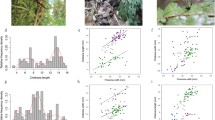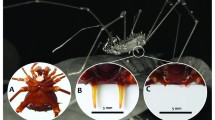Abstract
Male European earwigs (Forficula auricularia) possess substantially larger forceps than females and use these forceps to batter rivals in intrasexual contests to determine dominance. Although previous investigations have shown that male fighting and mating success increases with forceps size, it is not clear that sexual selection acts directly on forceps size per se; increased forceps size may be a correlated response to selection for some other trait. We experimentally reduced forceps length of males and paired them with unmanipulated males in staged encounters. Although apparent (postmanipulation) forceps length did not affect contest outcomes, original (premanipulation) forceps length did: males with longer original forceps won more contests. These results suggest that weapon size itself does not determine success in contests between male European earwigs. Thus, sexual selection may operate on forceps size in some other context or may act on some other trait that covaries with forceps size.
Similar content being viewed by others
REFERENCES
Alexander, R. D. (1961). Aggressiveness, territoriality, and sexual behavior in field crickets (Orthoptera: Cryllidae). Behaviour 17: 130–223.
Andersson, M. (1994). Sexual Selection, Princeton University Press, Princeton, NJ.
Brown, L., and Bartalon, J. (1986). Behavioral correlates of male morphology in a horned beetle. Am. Nat. 127: 565–570.
Conner, J. (1988). Field measurements of natural and sexual selection in the fungus beetle, Bolitotherus cornutus. Evolution 42: 735–749.
Conner, J. (1989). Density-dependent sexual selection in the fungus beetle, Bolitotherus cornutus. Evolution 43: 1378–1387.
Darwin, C. (1871). The Descent of Man, and Selection in Relation to Sex, Murray, London.
Eberhard, W. G., and Gutierrez, E. E. (1991). Male dimorphism in beetes and earwigs and the question of developmental constraints. Evolution 45: 18–28.
Giles, E. T. (1963). The comparative external morphology and affinities of the Dermaptera. Trans. R. Entomol. Soc. Lond. 115: 95–164.
Knabke, J. J., and Grigarick, A. A. (1971). Biology of the African earwig, Euborellia cincticollis (Gerstaecker), in California and comparative notes on Euborellia annulipes (Lucas). Hilgardia 41: 157–194.
Lamb, R. J. (1976). Polymorphisms among males of the European earwig, Forficula auricularia (Dermaptera: Forficulidae). Can. Entomol. 108: 69–75.
Lamb, R. J., and Wellington, G. (1975). Life history and population characteristics of the European earwig, Forficula auricularia (Dermaptera: Forficulidae), at Vancouver, British Columbia. Can. Entomol. 107: 819–824.
Media Cybernetics, L. P. (1997). Image-Pro Plus for Windows, Version 3.0, Media Cybernetics, L.P., Silver Spring, MD.
Moore, A. J., and Wilson, P. (1993). The evolution of sexually dimorphic earwig forces: Social interactions among adults of the toothed earwig, Vostax apicedentatus. Behav. Ecol. 4: 40–48.
Radesater, T., and Halldorsdottir, H. (1993a). Fluctuating asymmetry and forceps size in earwigs, Forficula auricularia. Anim. Behav. 45: 626–628.
Radesater, T., and Halldorsdottir, H. (1993b). Two male types of the common earwig: Male-male competition and mating success. Ethology 95: 89–96.
SAS Institute Inc. (1990). SAS/STAT User's Guide, Version 6, 4th ed., SAS Institute, Cary, NC.
Tompkins, J. L., and Simmons, L. W. (1996). Dimorphisms and fluctuating asymmetry in the forceps of male earwigs. J. Evol. Biol. 9: 753–770.
Tomkins, J. L., and Simmons, L. W. (1998). Female choice and manipulations of forces size and symmetry in the earwig Forficula auricularia L. Anim. Behav. 56: 347–356.
Zeh, D. W. (1987). Aggression, density, and sexual dimorphism in chernetid pseudoscorpions (Archnida: Pseudoscorpionida). Evolution 41: 1072–1087.
Author information
Authors and Affiliations
Rights and permissions
About this article
Cite this article
Styrsky, J.D., Van Rhein, S. Forceps Size Does Not Determine Fighting Success in European Earwigs. Journal of Insect Behavior 12, 475–482 (1999). https://doi.org/10.1023/A:1020962606724
Issue Date:
DOI: https://doi.org/10.1023/A:1020962606724




